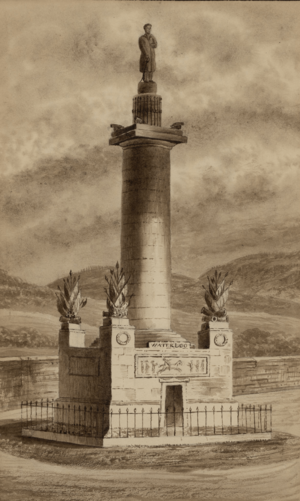Picton Monument, Carmarthen facts for kids
Quick facts for kids Picton Monument |
|
|---|---|
 |
|
| Location | Carmarthen |
| Built | 1847 |
|
Listed Building – Grade II
|
|
| Reference no. | 9503 |
| Lua error in Module:Location_map at line 420: attempt to index field 'wikibase' (a nil value). | |
The Picton Monument in Carmarthen, Wales, is a special memorial. It honors Lieutenant General Sir Thomas Picton. He was a very important British officer. He died during the famous Battle of Waterloo in 1815. This battle was a big event in history.
Sir Thomas Picton was born in Haverfordwest, Pembrokeshire. When he died, he owned land in Carmarthenshire. The monument you see today is made of limestone. It was built in 1847. It replaced an older monument that was falling apart.
The First Monument
In 1828, the first monument for Picton was put up. It was at the west end of Carmarthen. This tall pillar was about 75 feet high. It was designed by John Nash. He made it look like Trajan's column in Rome.
At the top of the pillar was a statue of Picton. It showed him wearing a cloak. The monument stood on a square base. You could go inside through a small door. This door faced the town. The monument had special carvings called reliefs. These were made by Edward Hodges Baily.
Above the door, it said "PICTON". There was also a carving showing Picton falling from his horse. This was at the Battle of Waterloo. The word "WATERLOO" was written above it. Another carving showed Picton climbing walls with his soldiers. This was during the Siege of Badajoz (1812).
On one side of the base, Picton's life story was written in English. On another side, it was written in Welsh. The base also had decorations like old weapons. The top of the square column had fake cannons.
But after only a few years, the monument started to break down. The carvings could not handle Carmarthen's bad weather. New carvings were made, but they were never put up. The whole pillar was taken down in 1846. Years later, in the 1970s, the replacement carvings were found. Now, you can see them at the Carmarthenshire County Museum.
The Current Monument
After the first monument was removed, a new one was planned. The architect F Fowler designed it. The first stone for this new monument was laid in 1847. It was placed on Monument Hill.
The new monument has words carved into it. It says: "Picton born August 24, 1758 Fell at Waterloo June 18, 1815". It also lists the names of his famous battles. These include Busaco, Badajos, Vittoria, Orthes, Toulouse, and Waterloo.
This monument became a listed building in 1981. This means it is an important historical structure. In 1984, the top part of the monument was taken down. It was not safe. Four years later, the whole monument was rebuilt. Each stone was put back carefully. It was given stronger foundations.
Discussions About the Monument
Sir Thomas Picton was a key figure in the Napoleonic Wars. However, his past is also controversial. He was involved in the Caribbean. During that time, he was known for using harsh methods. He also mistreated enslaved people. Some historical records mention his involvement in serious human rights issues.
In 2020, a statue of Edward Colston was removed in Bristol. After this, people started discussing other monuments. Wales Online reported that some people wanted to remove Picton's monuments. There were monuments in Carmarthen and Cardiff. In Cardiff, a statue and painting of Picton were taken down.
In Carmarthen, there was a campaign to change the monument. An online petition was started. It said that the monument should not honor Picton. This petition got almost 20,000 signatures. Another petition supported keeping the monument. It said Picton was a patriot. It also mentioned his military successes and bravery.
A group from the Carmarthenshire County Council looked into the monument. They suggested putting up information boards nearby. These boards would explain Picton's military career. They would also mention his links to slavery. Permission was given for these boards. People are now waiting to see what the boards will say.


